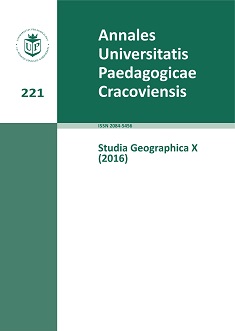Entrepreneurship in the smallest towns in the province of Lodz. Selected problems
Keywords:
economy of small towns, small town, entrepreneurship, Lodz regionAbstract
The article characterizes entrepreneurship in the smallest cities in the region of Lodz, which was for centers of up to 5 thousand. residents. In particular, in the cities, they traced and identified the pace and direction of development of economic entities, as well as an attempt to verify whether and to what extent the size of the city measured by the number of its inhabitants determines the tempo and undertaken in business. The study covered the period between 2004 and 2014 and used them in the following: the number of operators in total, the number of entrepreneurs - individuals, the number of commercial companies, including with foreign capital and the number of entities including selected sections of PKD. In addition, the article analyzes the development strategies all the cities studied for inclusion in their entrepreneurship issues. The study found that the number of inhabitants only slightly determines the level of entrepreneurial activity of its inhabitants. Much more important is the overall socio-economic situation of the city and the trust of its citizens to the local market.References
Brdulak, J., Kulikowski, M. (red.) (2004). Przedsiębiorczość – stymulatorem rozwoju. Warszawa: Instytut Wiedzy SGH.
Czarnecka, A., Kłodziński, M. (2010). Przedsiębiorczość pozarolnicza na obszarach wiejskich regionów zielonych płuc. Zagadnienia ekonomiki rolnej, 3, 63–78.
Fierla, I., Kuciński, K. (red.) (1999). Lokalne uwarunkowania przedsiębiorczości. Monografie i opracowania. Warszawa: SGH, 499.
Gaczek, W. (2003). Zarządzanie w gospodarce przestrzennej. Bydgoszcz–Poznań: Oficyna Wydawnicza Branta, 13–14.
Kamińska, W. (2006). Pozarolnicza indywidualna działalność gospodarcza w Polsce w latach 1988–2003. Prace Geograficzne, 203.
Korcelli, P. (2008). System osadniczy Polski – tendencje i uwarunkowania przemian. W: T. Markowski (red.), Koncepcja przestrzennego zagospodarowania kraju a wizje i perspektywy rozwoju przestrzennego Europy. Warszawa: Studia KPZK, 31.
Kulawiak, A. (2006). Przedsiębiorca jako uczestnik i twórca procesów transformacji. Przykład Łodzi. W: A. Jewtuchowicz, A. Suliborski (red.), Przestrzenne zróżnicowanie procesów transformacji społeczno-gospodarczej w regionie łódzkim. Łódź: Wyd. UŁ, 159–181.
Kulawiak, A. (2013). Społeczne uwarunkowania rozwoju sektora usług w małych miastach. Przykład Uniejowa. W: B. Bartosiewicz, T. Marszał (red.), Przestrzeń publiczna i sektor usług w małych miastach. Folia Geographica Socio-Oeconomica, 15. Łódź: Wyd. UŁ, 115–126.
Kulawiak, A. (2016). Rozwój Uniejowa jako wynik przedsiębiorczych działań władz samorządowych. W: M. Matejun (red.), Studia ekonomiczne regionu łódzkiego. Łódź: Wyd. PTE, 227–238.
Nowak, M., Kicka, E. (2012). Przedsiębiorczość w małych miastach województwa zachodniopomorskiego. Samorząd Terytorialny, 5.
Nowak, M., Lusarczyk, M. (2010). Przedsiębiorczość w najmniejszych miastach w Polsce. Studia Prawniczo-Ekonomiczne t. LXXXI, Łódź: Łódzkie Towarzystwo Naukowe, 330–341.
Płazik, M., Rachwał, T. (2015). „Przedsiębiorczy region” – zarys koncepcji w świetle analizy roli przedsiębiorczości w krajowej strategii rozwoju regionalnego. Przedsiębiorczość – Edukacja, 11, 37–49.
Suliborski, A., Walkiewicz, D. (2009). Współczesne zróżnicowanie społeczno-gospodarcze województwa łódzkiego. W: K. Badziak, M. Łapa (red.), Województwo łódzkie 1919–2009. Studia i materiały. Łódź: Polskie Towarzystwo Historyczne, 243–250.
Zioło, Z. (2016). Przedsiębiorczość w rozwoju układów lokalnych. Przedsiębiorczość – Edukacja, 12, 6–17.
Downloads
Published
Issue
Section
License
The submission of a paper to be published is synonymous with an agreement to transfer the copyright free of charge from the author to the publisher. The author also agrees to permit the publisher to publish the paper in printed form, open access online form, digital library form and other digital platforms with which the publisher has or will have a publishing agreement. Furthermore, the author agrees to not limit the number of copies that may be printed or issued by the publisher. In the case of co-authored papers, it is assumed that the corresponding author is authorized to represent the remaining co-authors in this respect. Authors are requested to sign a copyright declaration.

